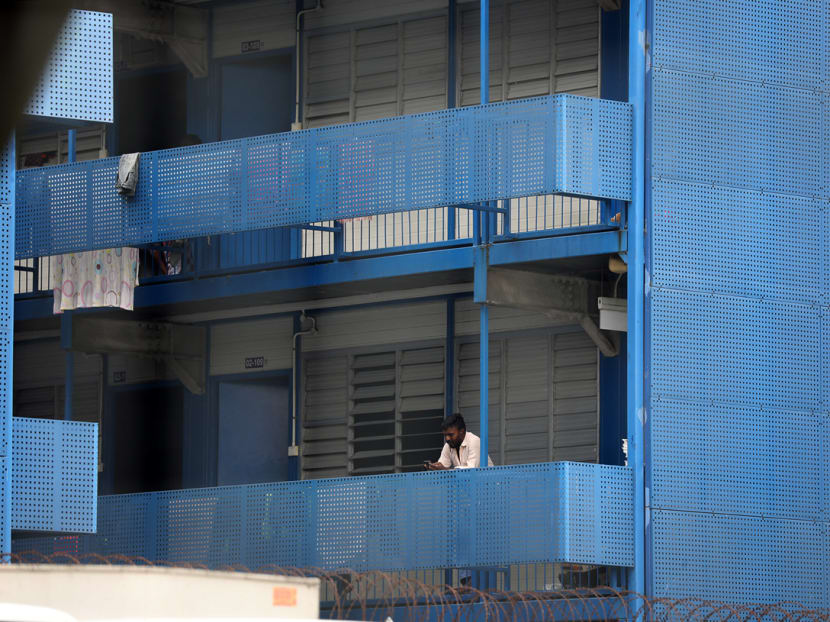Large-scale study of migrant workers’ mental health finds prolonged restrictions worsen depression, stress
SINGAPORE — Putting migrant workers under prolonged quarantines may be expedient in limiting Covid-19’s spread, but this comes at the cost of poorer mental health, a study has found.

Researchers surveyed 1,011 male migrant workers employed in manual jobs in Singapore to document their mental health symptoms and identify those at risk of poor mental health.
- A study was conducted by a team of Yale-NUS researchers who surveyed 1,011 migrant workers between June 22 and Oct 11, 2020
- Higher scores of depression and stress were reported by workers during complete movement restrictions
- Higher depression, anxiety and stress symptoms were also observed among participants more exposed to Covid-19 rumours
SINGAPORE — Putting migrant workers under prolonged quarantines may be expedient in limiting Covid-19’s spread, but this comes at the cost of poorer mental health, a study has found.
The study — said to be the first large-scale one here examining the mental health of such workers embroiled in coronavirus clusters — was conducted by a team of Yale-NUS researchers between June 22 and Oct 11 last year.
The researchers surveyed 1,011 male migrant workers employed in manual jobs here to document their mental health symptoms and identify those at risk of poor mental health.
They found that complete movement restrictions were associated with increased depression and stress, while being diagnosed with Covid-19 was associated with increased anxiety among the workers.
At the peak of the outbreak which led Singapore to enter a two-month circuit breaker period last April, more than 1,000 new Covid-19 cases were identified in dormitories daily.
While the vast majority of Singapore’s population has experienced many twists and turns over the past 15 months, as community restrictions get tightened or loosened in tandem with the pandemic situation, not much has changed for the 275,000-odd migrant workers staying in dormitories.
These workers have been largely confined to their rooms and only allowed to leave for work or, more recently, to designated recreation centres on some days.
WHAT RESEARCHERS FOUND
Rates of severe or extremely severe depression (3.1 per cent), anxiety (4.1 per cent) and stress in respondents (1.3 per cent) were similar to those observed in the general population in Singapore during the Covid-19 pandemic
Higher scores of depression and stress were observed among participants surveyed during complete movement restrictions, as compared to participants surveyed during minimal restrictions
In terms of health concerns, being diagnosed with Covid-19 predicted increased anxiety
Those who were fearful about their health during the pandemic reported more symptoms of depression, anxiety and stress than those who were not fearful
Participants who rated their health status as being good had fewer symptoms than those who rated their health as poor or normal
Higher depression, anxiety and stress symptoms were found among participants who feared losing their job during the pandemic
Higher depression, anxiety and stress symptoms were also observed among participants with higher exposure to Covid-19 rumours than those with lower exposure
RECOMMENDATIONS MADE
The large number of mental health symptoms reported among workers under complete restrictions suggests that while isolation of whole facilities may be expedient for limiting Covid-19 transmission, this comes at the cost of an increased mental health burden, researchers said.
As an alternative, other containment strategies should be prioritised such as frequent swab tests in migrant worker groups and using digital contact tracing to track possible transmission, which have already been implemented.
In the longer run, efforts can also be taken to reduce the density of migrant workers’ work and living environments.
Reducing density is not something that can be done overnight, said Yale-NUS Assistant Professor of Social Sciences (Psychology) Jean Liu, who led the study.
“In general, a major public health strategy in the pandemic has been to reduce the number of people congregating together. In the context of migrant worker dorms, we’re talking about 400,000 workers residing in dormitories that host up to 25,000 residents,” Asst Prof Liu said in an email interview with TODAY.
“While reduced density can prevent the spread of infection (and the stressors associated with this), we’re recommending a broader suite of measures to support migrant workers in the longer run. Where possible, we need to allay fears about job security, to promote health, to tackle rumours and to review movement restrictions,” she added.
The study also found that participants with higher exposure to Covid-19 rumours reported elevated depression, anxiety and stress symptoms.
“If supported by further studies, these results could shine a spotlight on the language and social barriers that many migrant workers encounter in their host countries, preventing access to official information sources that can provide assurance and counteract rumours,” researchers said.
“Additionally, many of our (mental health) screening and treatment tools are not appropriate. There are language and cultural barriers that render them less effective for migrant workers, and we need to bridge this gap,” added Asst Prof Liu.








